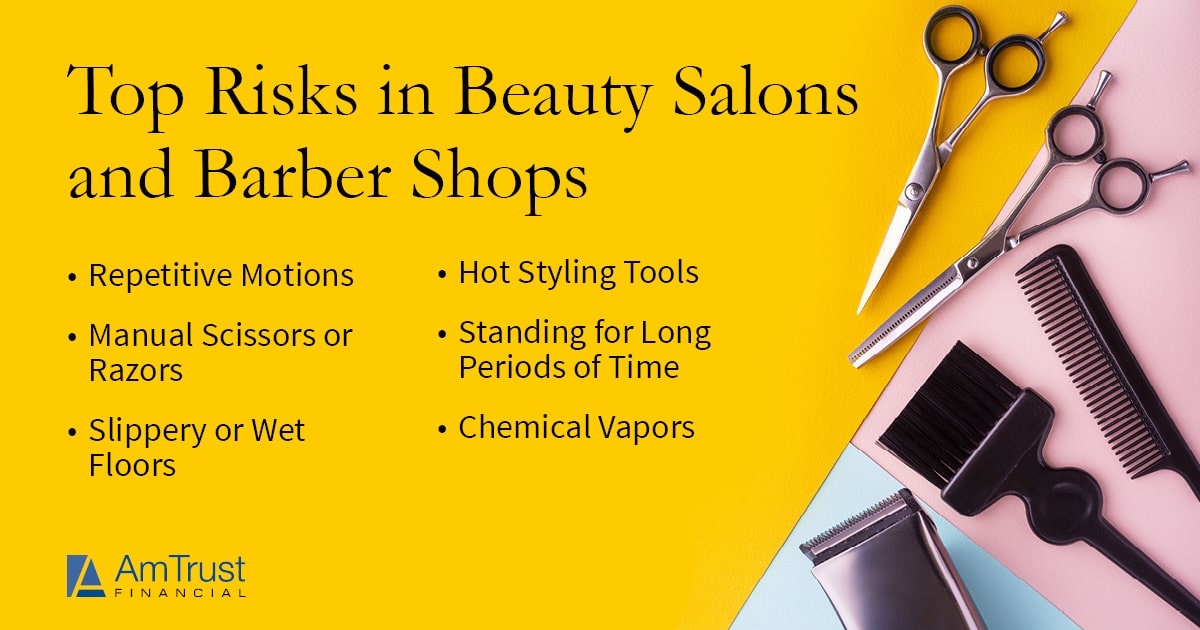Salon Safety: What Are Common Hazards in Beauty Salons and Barbershops?
People feel good when they step out of the salon. A fresh haircut, some trendy highlights or even just a simple trim and shave can boost one’s confidence and add a little pep to one’s step. Clients leave the hair salon or barbershop excited over their new look, without knowing that the person behind the chair every day could be at risk for a variety of on-the-job hazards putting their health and safety at risk.
Consider the popular Brazilian Blowout. Also known as a keratin treatment, a Brazilian Blowout is a semi-permanent hair straightening method that temporarily seals liquid keratin and a preservative solution into the hair using a flat iron. The goal is to eliminate and tame frizz while straightening out curls and waves, and the treatment usually lasts around three months.

This sounds like a dream come true for many clients, but in 2010 controversy surrounded the popular treatment due to formaldehyde, a toxic chemical, being one of the active ingredients for the process. Many of the products actually claimed to be formaldehyde-free, however, during
OSHA investigations, air tests in some salons showed formaldehyde at levels above OSHA limits. Studies showed these treatments can contain up to 7% formaldehyde and the risks to stylists include nose irritation and nosebleeds, bleeding gums and allergic reactions. The best defense against these reactions would be to eliminate using these products altogether, but at the very least salons must comply with OSHA’s
formaldehyde and hazard communication standards.
Examples of Risks in a Hair Salon or Barbershop

Exposure to formaldehyde in the air isn’t the only hazard hairstylists and barbers face on a daily basis, leaving some to wonder if it is safe to go to the barbers or beauty shop in the first place. Illnesses and injuries to beauty salon or barbershop employees can also be caused by:
Repetitive motions Hairstylists experience a variety of repetitive motions in their daily duties, from using scissors to trim clients’ hair to vibration from blow dryers, especially when drying long hairstyles. These motions can lead to muscle strains and other injuries, such as carpal tunnel syndrome.
Manual scissors and/or razors Cutting tools like scissors, shears, electric clippers and shaping are used daily by hairstylists and barbers to trim, layer, thin and shape hairstyles to their clients’ liking. “Scissor slips” can easily lead to lacerations on the fingers and hands of hairstylists. Cuts, punctures and scrapes are the second most common injury group for retail operations, according to information from
AmTrust’s Retail Risk Report, leading to over 4,200 claims over a three-year period.
Slippery or wet floors Injuries from falls and slips are closely behind cuts, punctures and scrapes when it comes to top injury groups for retail stores, including hair salons and barbershops. Products can spill, water can splash from sinks, or hair clippings that aren’t swept up in a timely manner can make floors slippery and dangerous for employees.
 Hot styling tools
Hot styling tools Curling irons, straightening irons, blow dryers and hot rollers are all tools used regularly to style clients’ hair to perfection in salons. These tools are often heated to over 400 degrees and can easily burn employees who move too quickly or bump into other workers’ stations.
Standing for long periods of time Hairstylists and barbers often stand in the same spot at their station for hours on end. This can lead to lower back pain, as standing increases pressure on the spine. Employees may also experience leg cramps or swollen, painful feet.
Chemical vapors Chemicals found in many of the products hairstylists use on a daily basis can also pose a health risk. Formaldehyde, as mentioned previously, can lead to irritations in the nose, eyes, throat, skin and respiratory systems. Other common salon products contain hazardous substances, too, such as hair dyes, bleaches and perm solutions. If the salon offers nail services, nail polish, hardeners, removers and acrylics can also release harmful vapors into the air.
Salon Safety Tips to Improve Customer Health and Safety
The first step in reducing or eliminating the risks in a hair salon or barbershop is to train all employees to keep their areas organized, clean and safe. Any spills should be mopped up immediately and hair clippings swept and thrown away to limit the chance of a fall or slip.

Employees should also understand what types of chemicals are in the products they use regularly, as well as how these chemicals may react when mixed together. It’s recommended that workers use personal protective equipment (PPE) like
gloves to keep products off the skin or masks to limit their exposure to chemical vapors.
Floor mats can be provided to help ease the pain employees feel in their backs, legs and feet from standing in the same position for several hours at a time. Hair salon owners or managers should implement a break schedule, too, to ensure stylists have time in between appointments to rest their hands and wrists before starting on the next client.
Loss Control Services from AmTrust Financial
AmTrust Financial’s
Loss Control department can provide the right
safety resources and commercial property safeguards to ensure your small business thrives.
Contact us today to learn more.
This material is for informational purposes only and is not legal or business advice. Neither AmTrust Financial Services, Inc. nor any of its subsidiaries or affiliates represents or warrants that the information contained herein is appropriate or suitable for any specific business or legal purpose. Readers seeking resolution of specific questions should consult their business and/or legal advisors. Coverages may vary by location. Contact your local RSM for more information.